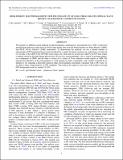| dc.contributor.author | Blackburn, Lindy L. | |
| dc.contributor.author | Briggs, Michael S. | |
| dc.contributor.author | Camp, J. | |
| dc.contributor.author | Christensen, N. | |
| dc.contributor.author | Connaughton, V. | |
| dc.contributor.author | Jenke, P. | |
| dc.contributor.author | Veitch, J. | |
| dc.contributor.author | Remillard, Ronald A | |
| dc.date.accessioned | 2015-05-28T17:48:17Z | |
| dc.date.available | 2015-05-28T17:48:17Z | |
| dc.date.issued | 2015-03 | |
| dc.date.submitted | 2014-09 | |
| dc.identifier.issn | 1538-4365 | |
| dc.identifier.issn | 0067-0049 | |
| dc.identifier.uri | http://hdl.handle.net/1721.1/97097 | |
| dc.description.abstract | We present two different search methods for electromagnetic counterparts to gravitational-wave (GW) events from ground-based detectors using archival NASA high-energy data from the Fermi Gamma-ray Burst Monitor (GBM) and RXTE All-sky Monitor (ASM) instruments. To demonstrate the methods, we use a limited number of representative GW background noise events produced by a search for binary neutron star coalescence over the last two months of the LIGO-Virgo S6/VSR3 joint science run. Time and sky location provided by the GW data trigger a targeted search in the high-energy photon data. We use two custom pipelines: one to search for prompt gamma-ray counterparts in GBM, and the other to search for a variety of X-ray afterglow model signals in ASM. We measure the efficiency of the joint pipelines to weak gamma-ray burst counterparts, and a family of model X-ray afterglows. By requiring a detectable signal in either electromagnetic instrument coincident with a GW event, we are able to reject a large majority of GW candidates. This reduces the signal-to-noise ratio of the loudest surviving GW background event by around 15–20%. | en_US |
| dc.description.sponsorship | National Science Foundation (U.S.) (Grant PHY-1204371) | en_US |
| dc.language.iso | en_US | |
| dc.publisher | IOP Publishing | en_US |
| dc.relation.isversionof | http://dx.doi.org/10.1088/0067-0049/217/1/8 | en_US |
| dc.rights | Article is made available in accordance with the publisher's policy and may be subject to US copyright law. Please refer to the publisher's site for terms of use. | en_US |
| dc.source | IOP Publishing | en_US |
| dc.title | HIGH-ENERGY ELECTROMAGNETIC OFFLINE FOLLOW-UP OF LIGO-VIRGO GRAVITATIONAL-WAVE BINARY COALESCENCE CANDIDATE EVENTS | en_US |
| dc.type | Article | en_US |
| dc.identifier.citation | Blackburn, L., M. S. Briggs, J. Camp, N. Christensen, V. Connaughton, P. Jenke, R. A. Remillard, and J. Veitch. “HIGH-ENERGY ELECTROMAGNETIC OFFLINE FOLLOW-UP OF LIGO-VIRGO GRAVITATIONAL-WAVE BINARY COALESCENCE CANDIDATE EVENTS.” The Astrophysical Journal Supplement Series 217, no. 1 (March 1, 2015): 8. © 2015 The American Astronomical Society | en_US |
| dc.contributor.department | MIT Kavli Institute for Astrophysics and Space Research | en_US |
| dc.contributor.mitauthor | Remillard, Ronald Alan | en_US |
| dc.relation.journal | The Astrophysical Journal. Supplement Series | en_US |
| dc.eprint.version | Final published version | en_US |
| dc.type.uri | http://purl.org/eprint/type/JournalArticle | en_US |
| eprint.status | http://purl.org/eprint/status/PeerReviewed | en_US |
| dspace.orderedauthors | Blackburn, L.; Briggs, M. S.; Camp, J.; Christensen, N.; Connaughton, V.; Jenke, P.; Remillard, R. A.; Veitch, J. | en_US |
| mit.license | PUBLISHER_POLICY | en_US |
| mit.metadata.status | Complete | |
